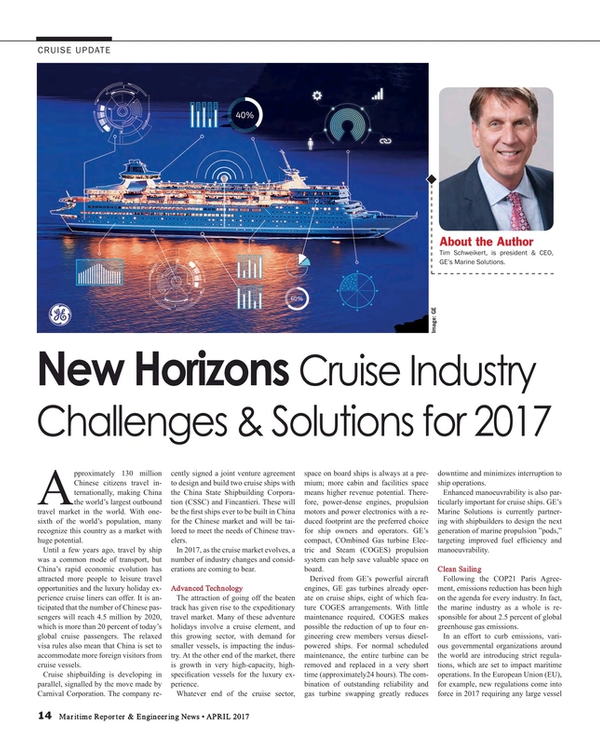
New Horizons: Cruise Industry Challenges & Solutions for 2017
By Tim Schweikert
Approximately 130 million Chinese citizens travel internationally, making China the world’s largest outbound travel market in the world. With one-sixth of the world’s population, many recognize this country as a market with huge potential.
Until a few years ago, travel by ship was a common mode of transport, but China’s rapid economic evolution has attracted more people to leisure travel opportunities and the luxury holiday experience cruise liners can offer. It is anticipated that the number of Chinese passengers will reach 4.5 million by 2020, which is more than 20 percent of today’s global cruise passengers. The relaxed visa rules also mean that China is set to accommodate more foreign visitors from cruise vessels.
Cruise shipbuilding is developing in parallel, signalled by the move made by Carnival Corporation. The company recently signed a joint venture agreement to design and build two cruise ships with the China State Shipbuilding Corporation (CSSC) and Fincantieri. These will be the first ships ever to be built in China for the Chinese market and will be tailored to meet the needs of Chinese travelers.
In 2017, as the cruise market evolves, a number of industry changes and considerations are coming to bear.
Advanced Technology
The attraction of going off the beaten track has given rise to the expeditionary travel market. Many of these adventure holidays involve a cruise element, and this growing sector, with demand for smaller vessels, is impacting the industry. At the other end of the market, there is growth in very high-capacity, high-specification vessels for the luxury experience.
Whatever end of the cruise sector, space on board ships is always at a premium; more cabin and facilities space means higher revenue potential. Therefore, power-dense engines, propulsion motors and power electronics with a reduced footprint are the preferred choice for ship owners and operators. GE’s compact, COmbined Gas turbine Electric and Steam (COGES) propulsion system can help save valuable space on board.
Derived from GE’s powerful aircraft engines, GE gas turbines already operate on cruise ships, eight of which feature COGES arrangements. With little maintenance required, COGES makes possible the reduction of up to four engineering crew members versus diesel-powered ships. For normal scheduled maintenance, the entire turbine can be removed and replaced in a very short time (approximately24 hours). The combination of outstanding reliability and gas turbine swapping greatly reduces downtime and minimizes interruption to ship operations.
Enhanced manoeuvrability is also particularly important for cruise ships. GE’s Marine Solutions is currently partnering with shipbuilders to design the next generation of marine propulsion ”pods,” targeting improved fuel efficiency and manoeuvrability.
Clean Sailing
Following the COP21 Paris Agreement, emissions reduction has been high on the agenda for every industry. In fact, the marine industry as a whole is responsible for about 2.5 percent of global greenhouse gas emissions.
In an effort to curb emissions, various governmental organizations around the world are introducing strict regulations, which are set to impact maritime operations. In the European Union (EU), for example, new regulations come into force in 2017 requiring any large vessel docking at an EU port to monitor and report its CO2 emissions.
In China, the government is creating emission control areas at major shipping ports, introducing a sulphur cap at 0.5 percent, ahead of the global IMO 2020 regulations.
To adhere to these regulations, marine operators need to rethink the most fundamental aspects of their operating models—how they consider everything from vessel design to vessel management to fuel choice and maintenance—to be compliant with the environmental regulations. New technologies can incur costs from development and upgrades, but also can bring efficiencies that lead to a fast return on investment and strengthen a market position for operators.
One way to embrace the change is through adopting cleaner engines, such as GE’s Tier 4 diesel engine, which meets IMO Tier III and US EPA Tier 4 requirements without the complications of urea after-treatment. Separately, GE’s marine gas turbines can be equipped with GE’s dry low emissions combustion system to reduce NOx.
The emission volume is well below what IMO Tier III and US EPA Tier 4 standards require and with no exhaust treatment and no methane slip.
Along the green wave, alternative clean fuel, such as LNG, will become a more predominant marine fuel. The move is typified by Carnival Corporation, which has three LNG-powered cruise ships on order. In addition, GE’s fuel-flexible COGES system is capable of burning diverse fuels including LPG, natural gas, marine gas oil and other bio-synthetic paraffinic kerosene blends.
As the marine industry transitions increasingly to natural gas, GE’s Marine Solutions brings experience of working across the whole LNG value chain for two decades—from production to processing, transport and propulsion—to help achieve the smooth transition.
The Digital Wave
Booming demand is also incentivizing the cruise industry to dip into digital waters to further raise efficiency and ensure a smooth and pleasant journey for passengers.
Unplanned downtime for any cruise line can cause interruptions to passengers’ journeys, loss of revenues and potential brand damage. However, analytic tools can predict an equipment’s potential failure before it becomes an operational disruption, reducing downtime and more crucially, avoiding disruptions during the voyage. This predictivity can also enable a shift from calendar- to condition-based maintenance, further reducing maintenance cost.
Digital technology can also help improve fuel efficiency by analyzing weather conditions and current to optimize propulsion rate and speed. Furthermore, it can help operators make smart decisions to change to use cleaner fuels on the course of the route, depending on the speed needed, further curbing emissions and cost of fuel.
As the demand for cruise holidays soars, fleets continue to grow. While stringent regulations and new destinations may provide new challenges, they bring with them a host of opportunities. New regulations will push operators towards more efficient operations with reduced carbon footprint, while new destinations open up new revenue streams. By using the right technology—green and digital—operators are sailing in the right direction to capitalize on the opportunities in 2017 as well as those further on the horizon.
The Author
Tim Schweikert, is president & CEO, GE’s Marine Solutions.
(As published in the April 2017 edition of Maritime Reporter & Engineering News)
Read New Horizons: Cruise Industry Challenges & Solutions for 2017 in Pdf, Flash or Html5 edition of April 2017 Maritime Reporter
Other stories from April 2017 issue
Content
- Lines in the Water page: 12
- New Horizons: Cruise Industry Challenges & Solutions for 2017 page: 14
- Firefighting on Workboats page: 16
- Op/Ed: CBP’S Lawful Jones Act Revocation page: 20
- IMO 2020: The Future of Fuel page: 22
- The (Battery) Power Play page: 26
- A Rising Sun of Change page: 32
- TUMSAT: More than a Rowing School page: 40
- Updated Forecast: Floating Production System Orders page: 42
- CFD Simulation of a Fully Featured Offshore Platform Model page: 44
- The Future (of Maritime) Care page: 48


